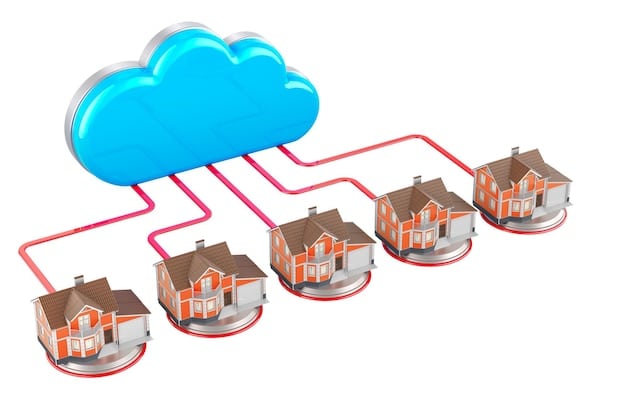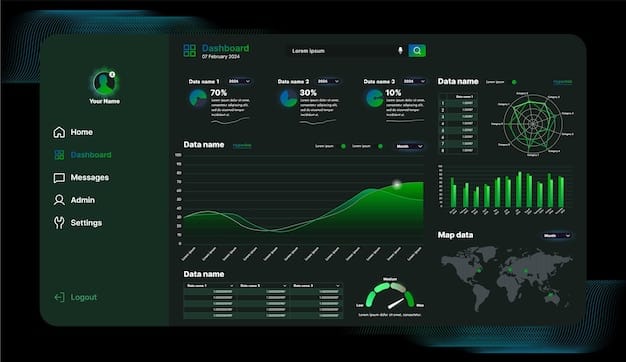Cloud Computing ROI: Maximizing Value with New Technologies

Cloud computing offers vast opportunities to enhance ROI, but only if organizations strategically adopt and leverage the latest cloud technologies to optimize efficiency and drive innovation.
Are you truly maximizing your return on investment (ROI) with cloud computing? The cloud has evolved far beyond simple data storage, with new technologies constantly emerging. Cloud computing: Are You Maximizing Your ROI with the Latest Cloud Technologies? It’s time to explore how to leverage these advancements and ensure your cloud strategy delivers tangible results.
Understanding the Current Cloud Landscape
The cloud computing landscape is dynamic, constantly evolving with new services and technologies. To maximize your ROI, it’s crucial to understand the current trends and how they can benefit your organization.
Let’s explore the key aspects of today’s cloud environment and how they impact your investment.
Key Cloud Computing Trends
Several trends are shaping the future of cloud computing. Understanding these trends is crucial for staying competitive and maximizing your cloud ROI.
- Hybrid Cloud: Combines public and private cloud resources, offering flexibility and control.
- Multi-Cloud: Utilizes multiple cloud providers, reducing vendor lock-in and improving resilience.
- Serverless Computing: Executes code without managing servers, optimizing resource utilization.
These trends enable businesses to create tailored cloud solutions that meet their specific needs and optimize costs.

The Importance of a Strategic Cloud Approach
A well-defined cloud strategy is essential for achieving a positive ROI. This involves aligning cloud initiatives with business goals and selecting the right technologies for your needs.
Without a strategic approach, organizations risk overspending, underutilizing resources, and failing to realize the full potential of cloud computing.
A strategic approach ensures that cloud investments are aligned with business priorities, leading to better outcomes and higher ROI.
In conclusion, understanding the current cloud landscape and adopting a strategic approach are critical for maximizing your ROI. This includes staying informed about emerging trends, selecting the right technologies, and aligning cloud initiatives with business goals.
Assessing Your Current Cloud Investments
Before adopting new cloud technologies, it’s essential to assess your current cloud investments. This involves evaluating performance, costs, and alignment with business objectives.
A comprehensive assessment helps identify areas for improvement and ensures that your cloud strategy is delivering the expected results.
Evaluating Cloud Performance Metrics
Key performance indicators (KPIs) provide valuable insights into the effectiveness of your cloud investments. Monitoring these metrics helps identify bottlenecks and optimize performance.
- Uptime: Measures the availability of cloud services.
- Latency: Tracks the time it takes for data to travel between systems.
- Resource Utilization: Monitors the efficiency of resource allocation.
By monitoring these KPIs, organizations can identify areas for improvement and optimize their cloud environment for better performance.
Cost Optimization Strategies
Cloud costs can quickly escalate if not managed effectively. Implementing cost optimization strategies helps control spending and maximize ROI.
Here are some effective cost optimization techniques:
- Right-Sizing: Adjusting resource allocation to match actual needs.
- Reserved Instances: Purchasing long-term commitments for discounted rates.
- Spot Instances: Utilizing spare capacity for cost-effective computing.
By implementing these strategies, organizations can significantly reduce their cloud spending and improve their ROI.
In summary, assessing your current cloud investments involves evaluating performance metrics and implementing cost optimization strategies. By monitoring KPIs and controlling spending, organizations can ensure that their cloud strategy is delivering a positive ROI.
Leveraging AI and Machine Learning in the Cloud
Artificial intelligence (AI) and machine learning (ML) are transforming cloud computing, enabling new levels of automation, insights, and efficiency. Leveraging these technologies can significantly enhance your cloud ROI.
Let’s explore how AI and ML can be integrated into your cloud strategy to drive innovation and optimize performance.
AI-Powered Automation
AI-powered automation can streamline cloud operations, reduce manual tasks, and improve efficiency. This includes automating tasks such as resource provisioning, security monitoring, and incident response.
With AI, routine tasks can be automated, freeing up IT staff to focus on more strategic initiatives and improving overall productivity.
AI-powered automation not only reduces costs but also enhances the reliability and consistency of cloud operations.
Data Analytics and Insights
AI and ML can be used to analyze vast amounts of cloud data, providing valuable insights into performance, usage patterns, and security threats. This data can be used to optimize resource allocation, improve security posture, and drive business innovation.
- Predictive Analytics: Forecasts future trends based on historical data.
- Anomaly Detection: Identifies unusual patterns that may indicate security threats.
- Personalized Recommendations: Provides tailored suggestions based on user behavior.
By leveraging AI and ML for data analytics, organizations can gain a deeper understanding of their cloud environment and make data-driven decisions to improve ROI.

In conclusion, leveraging AI and machine learning in the cloud can significantly enhance your ROI by automating operations, providing valuable insights, and improving decision-making. By integrating these technologies into your cloud strategy, organizations can drive innovation and optimize performance.
Securing Your Cloud Environment with Advanced Technologies
Cloud security is a critical aspect of cloud computing. Implementing advanced security technologies helps protect your data and applications from evolving threats, ensuring the integrity and availability of your cloud environment.
Let’s discuss how advanced security technologies can enhance your cloud security posture and protect your investments.
Advanced Threat Detection
Traditional security measures are often insufficient to detect advanced threats. Advanced threat detection technologies use AI and ML to identify and respond to sophisticated attacks in real-time.
- Behavioral Analysis: Detects anomalies in user and system behavior.
- Threat Intelligence: Gathers and analyzes threat data from various sources.
- Automated Response: Automatically responds to detected threats.
By implementing these technologies, organizations can improve their threat detection capabilities and minimize the impact of security incidents.
Data Encryption and Access Control
Data encryption and access control are essential for protecting sensitive data in the cloud. Encryption ensures that data is unreadable to unauthorized users, while access control restricts access to authorized personnel only.
Implementing robust encryption and access control measures helps prevent data breaches and ensures compliance with regulatory requirements.
These measures not only protect data but also build trust with customers and stakeholders.
In summary, securing your cloud environment with advanced technologies is crucial for protecting your data and applications from evolving threats. By implementing advanced threat detection and robust data encryption and access control measures, organizations can ensure the integrity and availability of their cloud environment and protect their investments.
Optimizing Cloud Storage and Data Management
Efficient cloud storage and data management are essential for maximizing your cloud ROI. Optimizing storage costs, improving data access, and implementing effective data governance policies can significantly enhance the value of your cloud investments.
Let’s explore how to optimize your cloud storage and data management practices to drive efficiency and reduce costs.
Tiered Storage Solutions
Tiered storage solutions automatically move data between different storage tiers based on access frequency. This ensures that frequently accessed data is stored on high-performance, expensive storage, while infrequently accessed data is stored on lower-cost storage.
By implementing tiered storage, organizations can significantly reduce their storage costs without impacting performance.
Tiered storage ensures that resources are allocated efficiently, optimizing the overall cost-effectiveness of cloud storage.
Data Compression and Deduplication
Data compression and deduplication techniques reduce the amount of storage space required by compressing data and eliminating duplicate copies. This can significantly lower storage costs and improve performance.
These techniques are particularly effective for large datasets and can result in substantial savings.
Data compression and deduplication not only reduce storage costs but also improve data transfer speeds and backup efficiency.
In conclusion, optimizing cloud storage and data management is crucial for maximizing your cloud ROI. By implementing tiered storage solutions and utilizing data compression and deduplication techniques, organizations can drive efficiency, reduce costs, and improve data access, ensuring the long-term value of their cloud investments.
Future-Proofing Your Cloud Strategy
To ensure long-term success with cloud computing, it’s essential to future-proof your cloud strategy. This involves staying informed about emerging technologies, adapting to changing business needs, and building a flexible and scalable cloud environment.
Let’s explore how to prepare your cloud strategy for the future and maximize your ROI over the long term.
Embracing Emerging Technologies
Staying informed about emerging technologies is crucial for future-proofing your cloud strategy. Technologies such as quantum computing, edge computing, and blockchain have the potential to transform cloud computing and create new opportunities for innovation.
By embracing these technologies, organizations can gain a competitive edge and drive long-term growth.
Staying ahead of the curve ensures that your cloud strategy remains relevant and effective in the face of rapid technological advancements.
Building a Scalable and Flexible Cloud Environment
A scalable and flexible cloud environment is essential for adapting to changing business needs. This involves designing your cloud architecture to easily scale up or down resources as demand fluctuates and to support new applications and services as they emerge.
- Microservices Architecture: Breaks down applications into small, independent services.
- Containerization: Packages applications and their dependencies into containers for easy deployment.
- Infrastructure as Code: Manages infrastructure using code, enabling automation and repeatability.
By building a scalable and flexible cloud environment, organizations can quickly adapt to changing business needs and maximize their ROI over the long term.
| Key Point | Brief Description |
|---|---|
| 💡Strategic Cloud Approach | Align cloud initiatives with business goals for optimal ROI. |
| 🤖AI & ML Integration | Use AI for automation and ML for data insights to improve efficiency. |
| 🛡️Advanced Security | Implement advanced threat detection and data encryption. |
| ☁️Storage Optimization | Optimize storage by using tiered solutions and data compression. |
FAQ
▼
Hybrid cloud combines public and private cloud resources, optimizing cost and flexibility. It enables organizations to use the resources that meet their specific needs while controlling sensitive data.
▼
AI revolutionizes security by automating threat identification, improving precision. AI algorithms analyze vast volumes of security data to flag suspicious activities, minimizing response times.
▼
Tiered storage involves storing data differently based on access patterns. This helps to cut costs by housing less-accessed information on low-cost storage devices and quickly retrieving frequently accessed data.
▼
Data compression reduces the size of stored files, which translates directly to less storage space needed. Ultimately, it lowers your cloud data storage financial burden when archiving large content.
▼
Future-proofing ensures that your cloud remains relevant under technological advances. By staying malleable, your environment can embrace innovative tools, making it more efficient and more adaptable.
Conclusion
By understanding the current landscape, assessing existing investments, and embracing new technologies, organizations in the US can truly unlock cloud computing ROI. A strategic and proactive approach ensures that cloud investments drive efficiency, innovation, and long-term value.





